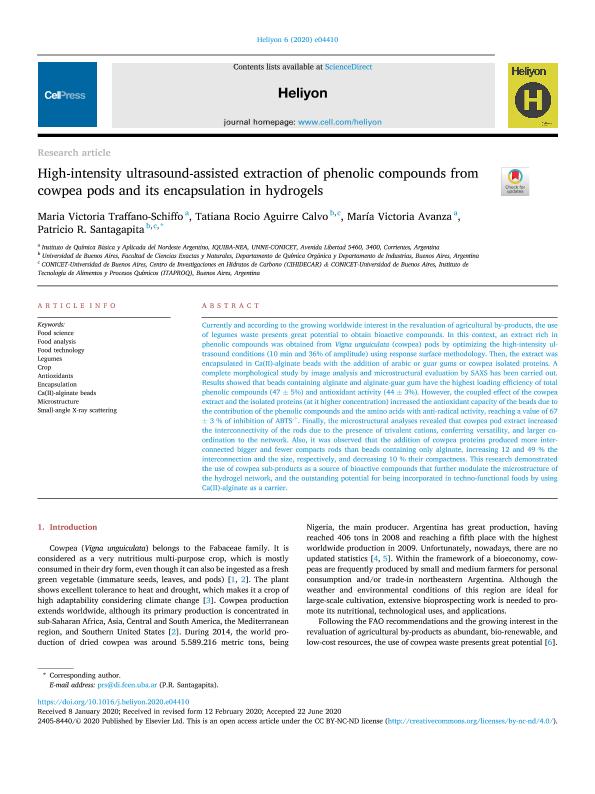Artículo
High-intensity ultrasound-assisted extraction of phenolic compounds from cowpea pods and its encapsulation in hydrogels
Traffano Schiffo, Maria Victoria ; Aguirre Calvo, Tatiana Rocio
; Aguirre Calvo, Tatiana Rocio ; Avanza, María Victoria
; Avanza, María Victoria ; Santagapita, Patricio Roman
; Santagapita, Patricio Roman
 ; Aguirre Calvo, Tatiana Rocio
; Aguirre Calvo, Tatiana Rocio ; Avanza, María Victoria
; Avanza, María Victoria ; Santagapita, Patricio Roman
; Santagapita, Patricio Roman
Fecha de publicación:
07/2020
Editorial:
Elsevier
Revista:
Heliyon
ISSN:
2405-8440
Idioma:
Inglés
Tipo de recurso:
Artículo publicado
Clasificación temática:
Resumen
Currently and according to the growing worldwide interest in the revaluation of agricultural by-products, the use of legumes waste presents great potential to obtain bioactive compounds. In this context, an extract rich in phenolic compounds was obtained from Vigna unguiculata (cowpea) pods by optimizing the high-intensity ultrasound conditions (10 min and 36% of amplitude) using response surface methodology. Then, the extract was encapsulated in Ca(II)-alginate beads with the addition of arabic or guar gums or cowpea isolated proteins. A complete morphological study by image analysis and microstructural evaluation by SAXS has been carried out. Results showed that beads containing alginate and alginate-guar gum have the highest loading efficiency of total phenolic compounds (47 +/- 5%) and antioxidant activity (44 +/- 3%). However, the coupled effect of the cowpea extract and the isolated proteins (at it higher concentration) increased the antioxidant capacity of the beads due to the contribution of the phenolic compounds and the amino acids with anti-radical activity, reaching a value of 67 +/- 3 % of inhibition of ABTS.+. Finally, the microstructural analyses revealed that cowpea pod extract increased the interconnectivity of the rods due to the presence of trivalent cations, conferring versatility, and larger coordination to the network. Also, it was observed that the addition of cowpea proteins produced more interconnected bigger and fewer compacts rods than beads containing only alginate, increasing 12 and 49 % the interconnection and the size, respectively, and decreasing 10 % their compactness. This research demonstrated the use of cowpea sub-products as a source of bioactive compounds that further modulate the microstructure of the hydrogel network, and the outstanding potential for being incorporated in techno-functional foods by using Ca(II)-alginate as a carrier.
Archivos asociados
Licencia
Identificadores
Colecciones
Articulos(IQUIBA-NEA)
Articulos de INSTITUTO DE QUIMICA BASICA Y APLICADA DEL NORDESTE ARGENTINO
Articulos de INSTITUTO DE QUIMICA BASICA Y APLICADA DEL NORDESTE ARGENTINO
Articulos(ITAPROQ)
Articulos de INSTITUTO DE TECNOLOGIA DE ALIMENTOS Y PROCESOS QUIMICOS
Articulos de INSTITUTO DE TECNOLOGIA DE ALIMENTOS Y PROCESOS QUIMICOS
Citación
Traffano Schiffo, Maria Victoria; Aguirre Calvo, Tatiana Rocio; Avanza, María Victoria; Santagapita, Patricio Roman; High-intensity ultrasound-assisted extraction of phenolic compounds from cowpea pods and its encapsulation in hydrogels; Elsevier; Heliyon; 6; 7; 7-2020; 1-11
Compartir
Altmétricas



